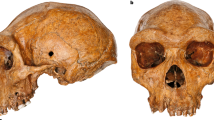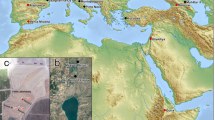Abstract
THE interesting article by Prof. Wood Josnes1 on the recently discovered Keilor skull and its bearing on the antiquity of man in Australia invites attention to the fact that Homo sapiens occurs in Australia in a Pleistocene deposit. I should like to stress an important implication of this discovery, namely, that if the age of the skull as suggested by Mahony2 can be confirmed, a form of Homo sapiens existed in Australia when Homo neanderthalensis lived in Europe.
This is a preview of subscription content, access via your institution
Access options
Subscribe to this journal
Receive 51 print issues and online access
$199.00 per year
only $3.90 per issue
Buy this article
- Purchase on Springer Link
- Instant access to full article PDF
Prices may be subject to local taxes which are calculated during checkout
Similar content being viewed by others
References
NATURE, 153, 211 (1944).
Mem. Nat. Mus. Melbourne, 13, 79 (1943).
Proc. Roy. Soc. Vict., 53, 233 (1941).
"Univ. Lond. Inst. Arch. Geochron. Tables", 2 (1940).
For map, see Trans. Zool. Soc. Land., 25, 154 (1943).
Author information
Authors and Affiliations
Rights and permissions
About this article
Cite this article
ZEUNER, F. Homo sapiens in Australia contemporary with Homo neanderthalensis in Europe. Nature 153, 622–623 (1944). https://doi.org/10.1038/153622b0
Issue Date:
DOI: https://doi.org/10.1038/153622b0
This article is cited by
-
Evolution of Modern Man (Homo sapiens)
Nature (1944)
Comments
By submitting a comment you agree to abide by our Terms and Community Guidelines. If you find something abusive or that does not comply with our terms or guidelines please flag it as inappropriate.



